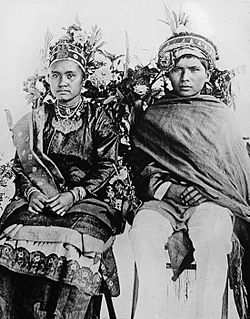Mandailing people

A photograph of a Mandailing couple from Pakantan, Mandailing Natal Regency, North Sumatra, Indonesia.
|
|
| Total population | |
|---|---|
| (1,700,000) | |
| Regions with significant populations | |
|
Indonesia: North Sumatra (1,035,000) West Sumatra (214,000) Riau (210,000) Jakarta (80,000) Malaysia (30,000) |
|
| Languages | |
| Mandailing, Malay, Indonesian | |
| Religion | |
| Islam (predominantly), Christianity | |
| Related ethnic groups | |
| Minangkabau people, Malay people, Alas people, Gayo people, Karo people, Batak people |
The Mandailing is a traditional cultural group in Southeast Asia. They are found mainly in the northern section of the island of Sumatra in Indonesia. They came under the influence of the Kaum Padri who ruled the Minangkabau of Tanah Datar. As a result, the Mandailing were influenced by Muslim culture and converted to Islam. There are also a group of Mandailing in Malaysia, especially in the states of Selangor and Perak. They are closely related to the Angkola.
The etymology of 'Mandailing' is said to be a coupounding of the words mande, meaning 'mother', and hilang, meaning 'lost'. Thus, the name is said to mean "lost mother". The Mandailing society is patriarchal, employing family names, or marga,. The well known margas in Mandailing clan are: Lubis, Nasution, Siregar, Hasibuan, Harahap, Dalimunthe (originally from Munthe), Matondang, Rangkuti, Parinduri, Pulungan, Rambe, Daulae(y), Pohan, Batubara (not to be confused with the Batu Bara people from the east coast of Sumatra), Barus and Hutajulu.
According to Tamboen's account (1952) the Mandailing, along with other sub-ethnic Batak groups are the descendants of one man by the name of Batak; who migrated to the south before the coming of the Portuguese and Dutch colonisation of Sumatra. Dutch colonization in Sumatra caused the Mandailing to be typecast as a sub-category of the Batak, as a 'wedge policy' to classify the communities and create typologies. It instilled the division of the Islamic nations by a non-Muslim belt, called 'Bataklanden' (Bataklands). The Mandailing were associated with the Toba Batak people instead of being recognized as a distinct ethnic minority. Consequently, the Mandailing people have been torn between two cultural and ethnic identities, namely Batak-Mandailing in Indonesia and Malay-Mandailing in Malaysia.
...
Wikipedia
